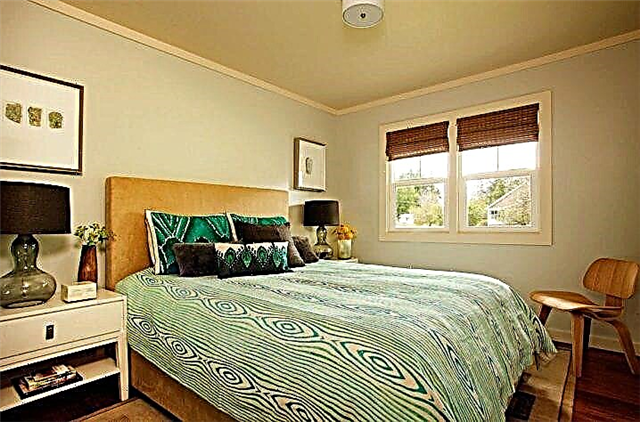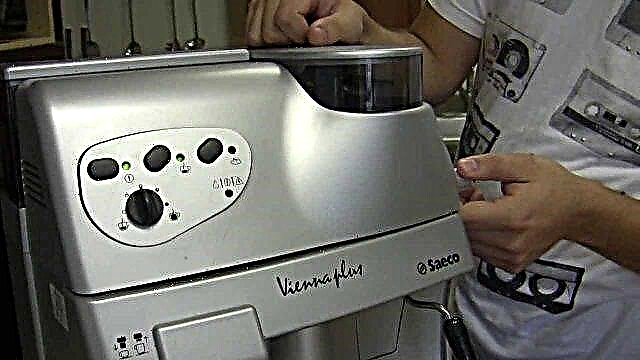 Every year there are more and more ideas for decorating a room. Their main purpose is to bring comfort and coziness to the home. Particular attention should be paid to the design of the window space. In addition to the main elements - curtains - you can find a variety of braid or chic lace lambrequins.
Every year there are more and more ideas for decorating a room. Their main purpose is to bring comfort and coziness to the home. Particular attention should be paid to the design of the window space. In addition to the main elements - curtains - you can find a variety of braid or chic lace lambrequins.
They are horizontal drapery, which is located in the upper part of the window opening. This is a short decorative element, equal in width to a cornice. It is customary to place it on top of the curtains.
Lambrequins can be of several types:
- curly
- fishnet
- bando.
Curtains decorated with such elements bring meaning to the room and emphasize the refined taste of the owner of the room. Patterns of lambrequin can overlap with patterns of lace curtains. They allow you to complement the overall interior of the room and attract attention.
Openwork lambrequins
Lambrequin, in the processing of which a laser machine was used, is usually called openwork. It is made from dense two-layer fabricsometimes use genuine leather. Fabric with polyester (in some cases leather) serves as the first layer; a soft base is used for the inside. The pattern that will be applied to the fabric goes through the digitization process and is stored on the computer. After that, a special laser cutter cuts out a given pattern. Pattern for carved lambrequin can be made to order. It depends on the financial capabilities and stylistic preferences of the customer.
Curtains with openwork lambrequin fit perfectly into almost any style and refresh it. To make it look more harmonious, he can repeat the pattern made on furniture or other interior items. It is recommended to attach this decor item to a special adhesive tape.
Advantage - simplicity in leaving and operation. If we are talking about openwork lambrequin, there is no need to iron or wash it. In addition, it is easily removed and attached without the help of specialists.
Materials for openwork lambrequins
You need to start with the materials. They determine the type, shape, durability and brightness of the pelmet.

Felt
Felt is classified as felt. Natural fabrics are made from sheepskin wool with the addition of any fluff. As a result, the material is soft, pleasant to the touch and airy. There is a cheap substitute - plastic felt.
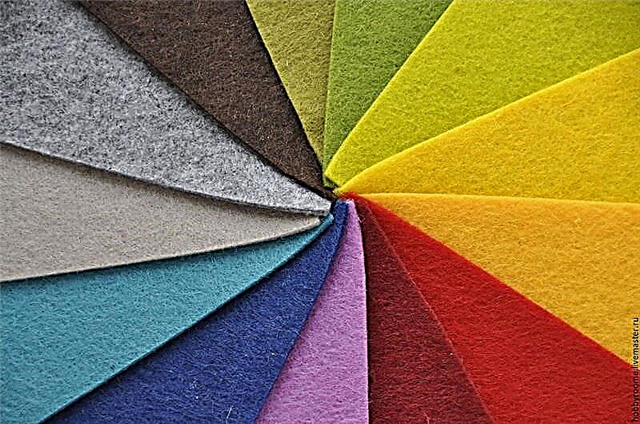
It is made of different types of plastic (nylon, polyester). It is tougher to the touch, does not have down qualities, but holds color well, is easier to cut with scissors and an office knife.

Since it is easier to sew openwork lambrequin from rolled fabric, plastic is suitable. It is not inclined to hitches, cheap, it is sold both by sheets of A4 format and by whole rolls. You can draw on it with an ordinary white marker or liner.

Cord
A unique, but labor-intensive material for openwork lambrequins. For a bunch you need a decorative cord. Hand-made stores sell different ropes in any color. It can be caramel, burgundy, black, gray. It is chosen to match the color of the curtains.

The principle is to weave and twist the cord in a special way, from which it becomes solid and does not lose its shape. It is possible to further starch it or cover it with a layer of glue to increase strength. It will not perform a practical function, but it will help to create an ornament.

Software
Durable but very soft material. It looks like a felt, but it is easily draped, which can be used in design. It is a fully artificial fabric made entirely of polyester. Therefore, breaking it is almost impossible.

Since this is plastic, the canvas dries instantly. Color does not fade in the sun, and the fabric itself is not prone to fading.
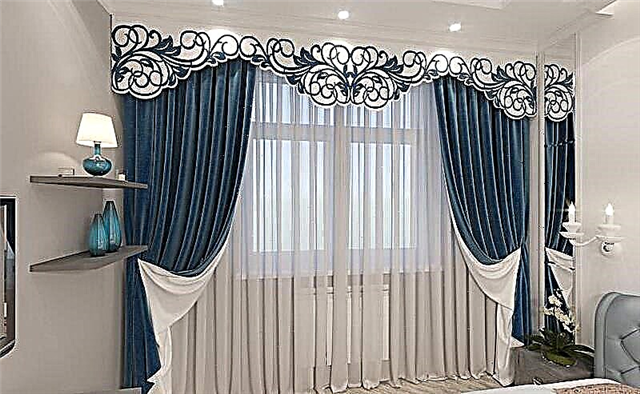
Tree
A wooden openwork lambrequin is stencil-cut using cutters and chisels. Despite the spectacularity, it is not appropriate in every design. This is an eternal element that is installed only once. For this, a cornice is bought, to which the part can be locked securely.

Chanzelise
Faux polyester fabric. Very soft to the touch, has average sun dimming. As a rule, one side has a matte texture, and the other is glossy.

How to sew an openwork lambrequin with your own hands
Do-it-yourself lambrequins with patterns for beginners can be done using the instructions below.






To do this, you need the following:
- Main fabric.
- Intermediate lining.
- Bando Openwork bandeau is the basis that is used for sewing curtains. There are centimeter and millimeter marks on it that will help make an even cutout.
- Fringed lining.
- Thread.
- A2 paper.
- Scissors.



After that, a finished sketch is taken. As a rule, it is printed on a printer. Below are the most convenient patterns for independent sewing.

Next, you need to follow the step-by-step plan:
A sketch is prepared and transferred to paper. After that, everything is cut using ordinary scissors. You need to be careful, since the subsequent carrying also depends on the quality of the cut. If there is no picture that fits in size, you can use graph paper. It will help to maintain proportions and increase the drawing to the desired size and transfer it without loss. The drawing paper is most often used (it is denser and stronger, in comparison with usual). If not, thick wallpapers will do.

- The resulting sketch is transferred to the bando.
- Now you need to glue the main fabric. Here, care must be taken to prevent bubbles. It is important that the material is synthetic. Unlike natural ones, they are not prone to shedding and threads from them do not climb. In addition, natural fibers are prone to starch. And this can lead to delamination and breakdown of the lambrequin.

- Using the glue web, you need to glue the substrate.
- At this point, you need to find a clipping method. Using scissors will not work, as the edges will be uneven in any case. The best way is laser cutting. This cannot be done independently, so you have to carry it in the studio providing such services. The edges are smooth, do not require editing, and no braid is created. You can use the thermal processing method. This will require a wood burner. It develops heat and instantly burns a small section that is not noticeable. The thinnest nozzle is used, which quickly passes through the stencil.
- A seam is laid along the edge.

This is a brief manufacturing instruction. You may notice that curly lambrequins are made in just one evening from any fabric. You can watch a master class on openwork lambrequins.
We sew a pelmet
- After the primary work has been done, it’s time to flash the edges. The easiest way is a sewing machine or an overlock. To do this, you can go to the studio and carry out the flashing of the edges. It is necessary to take two centimeters from the edge and flash it with skipped seams. A standard seam is used as standard, which does not close with anything and is not decorated. This is the simplest solution that shows an acceptable result. It is best to make a small stitch with a thread of the same color.
- In addition, you can use a slanting inlay. However, omissions should not be made. It is rarely used, especially if the lambrequins have a complex shape with a mass of bends. In this case, creases will certainly appear. In conjunction with the painstaking work, its duration and complexity, the result may be unsatisfactory.
- If there is no sewing machine or overlock, you can always use the usual thread with a needle. Labor is much more painstaking, requires more effort, but otherwise it will help to sew lambrequins. Here you can use a thread of the same color as the main material. The stitch should be small, consistent. Since loads on the decoration are not expected, thin threads can be used. Including fishing line for embroidery with beads.
- Lastly, fringe is installed. It is sewn with a thin stitch in arbitrary places. Especially it hides the flaws of the inlay, the crease and poorly stitched sections. It is already sold in whole strips.


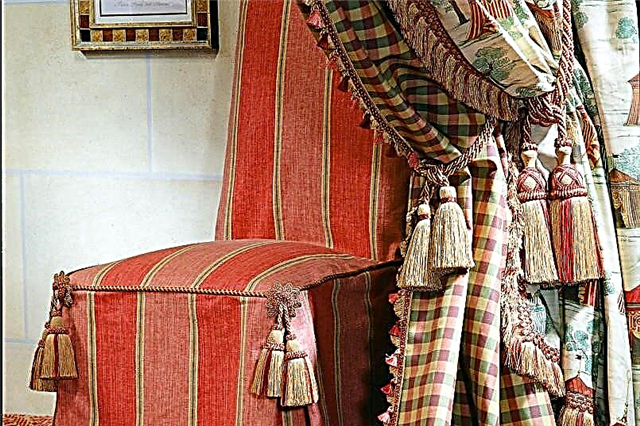
Cord pelmets
A completely different technology for which you do not need a sewing machine and a needle with a thread. Sewing curtains with your own hands and patterns for free download below.
This will require:
- Wire. You will need a diameter of 3 to 5 millimeters. Copper is best suited to bending. She is not prone to fractures, much softer than steel. Aluminum is too soft, so it is better not to take it.
- Whatman. You will need to sketch it.
- Cord. You can take a decorative lace in stores for hand-made. It is thick and presented in several colors. Furniture is also suitable. He has similar qualities.
- Glue gun. Hot melt adhesive is the fastest way to fix a rope to a wire. You can use a thin line and bandage the joints.
- Pliers. Needed to cut the wire and help bend it.
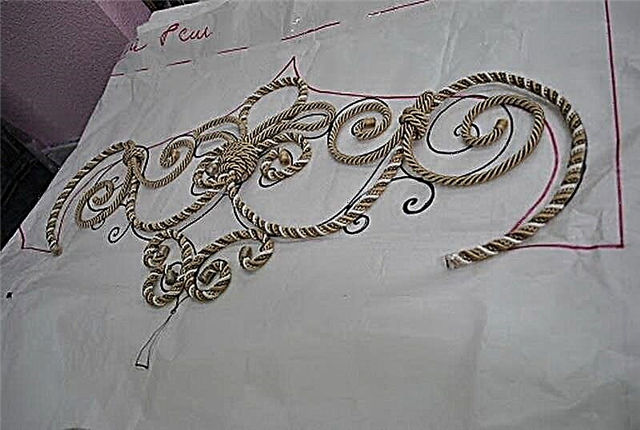
How to make an openwork lambrequin is described below in the instructions:
- A sketch is applied to the paper. You can download it or draw with a regular marker. Usually they are made mirrored, with a certain geometric dependence.

- The wire is tightly wrapped with a cord. It is important that the step is minimal, there are no gaps. To hold the lace, it must be fixed on one side with glue or rewound with an ordinary fishing line.
- When the whole wire is covered with a cord, the remaining end can be fixed and bent along the contour of the stencil. You can help with pliers if the wire does not bend.

- If the figured pelmet (the shape of a butterfly, hohloma), at the junction of the two ends, you need to tightly tie them with a thread. It is better to take a thread of a different color. it will get rid of knocks and make an additional design.
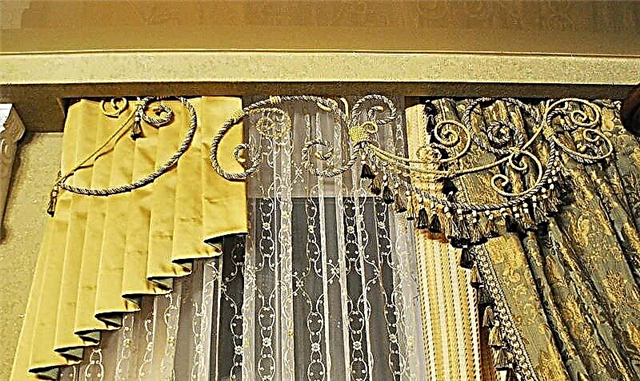
- In the future, you can use openwork bando and fabric. If you stick it or stick it on the back, you will get a non-hollow structure, which even sunlight will cover.

Do-it-yourself cord lambrequins with home patterns can be viewed below.
Patterns


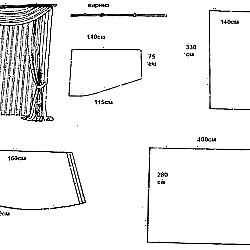


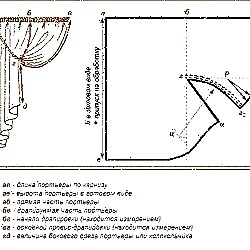


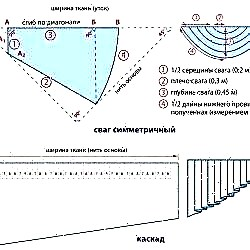


See photos of openwork lambrequins below.
What are lambrequins?
The word "lambrequin" has French roots and means "carved decoration." The item itself looks like a heavy drape placed across the window at the top of the frame.
For a long time, a complex and delicate ornament and lace patterns were used in the arrangement of the interior to give it a special charm and sophistication.
Additions usually include:
The wide range of options for picking, colors and shapes make it possible to create hundreds of different design options.
The main application of this element in the interior is aesthetic. Lambrequin covers cornices and empty space between two canvases, which completes the design of the window.
Depending on the style and design of the room, you can choose a suitable pattern, or create an original project yourself.
Additional information: With the help of a lambrequin it is also possible to visually reduce or enlarge a window opening. It all depends on how high or low he is hung, what form he has.
Depending on the style and design of the room, you can choose a suitable pattern, or create an original project yourself.
The windows decorated with carved lambrequins look sophisticated. The patterns look especially bright in combination with a plain light-colored fabric. There are many easy options for how to craft the decoration yourself.
Window decor with delicate elements will add zest to your interior.
How to correctly make flowers for lambrequins?
Plant motifs always remain popular, and flowers are able to bring a special charm to the interior of a room. Even a beginner needlewoman is capable of making voluminous fabric flowers with a garland of petals. It does not take a lot of costs and material.
The ability to mask unsuccessfully selected cornice and flaws in the architecture of the window opening.
To make it is necessary to have:
- non-woven,
- thin cardboard
- base fabric
- glue stick,
- slanting inlay
- decorative tape
- shiny beads
- a thread,
- scissors,
- iron.
Necessary materials and tools.
First you need a pattern of petals and leaves - at the initial stage we cut out the details from cardboard. It is best to chalk the resulting non-woven parts with chalk. In total, you need 3 large petals (with the calculation of the proportions of the lambrequin) and 5 smaller leaves. After that we proceed to the main work.
- We glue the non-woven glue and apply it to the wrong side of the fabric.
- Carefully cut the fabric blanks for both sides - a total of 6 and 10.
- First, we carry out a heated iron on one side. When the product will hold tight, use a glue stick and apply the second part of the fabric.
- Next, you need to refine the edges with an inlay in order to remove the flaws.
- When each piece is glued and processed, we proceed to the assembly.
It adorns the curtain composition, acting as an exclusive addition, giving the window design a bright personality.
Gathering a flower, try to use imagination. We connect the three petals with a thread, covering the place of connection with a bundle of decorative tape. Double-stitched ribbon fasten the leaves, add the beads on the threads. You should get a graceful leafy garland. For splendor, you can omit several ribbons without foliage.
A variety of shapes, designs and colors allows you to choose a bando model for any interior.
Important! Pay attention to the color scheme. The edging of the flower should match the color of the ribbons.
What are the features of a double openwork lambrequin?
Curly lambrequins can be fixed on top of ordinary ones, which gives the overall picture a special touch. Regarding the shade - it is better to create a sharp contrast between the background and the patterned decor. In the presence of the usual fabric decoration, you just need to fasten the openwork part on top. You will need to make sure that the patterns for the second layer go well with other interior solutions on the windows.
The pattern of products is simple, with concise clear lines and complex, with ornate carved weaves of a single fantasy pattern.
You can find a lot of monograms, ornaments and stencils for lambrequins to create your own style. Varieties of window decoration, often consisting of several parts, are striking in their diversity.
The value of handmade products is undeniable: these are real works of art.
The whole picture usually consists of such details as:
- swag (sagging piece of fabric with assemblies),
- dzhabot (the fabric cascade falling down on edge),
- tie (lancet horizontal folds),
- puffs (lush and puffy patterns),
- cocillier (acute angle central element).
Presented products can be made from a set of the following elements.
Note! You always need to combine elements in such a way that bright, eye-catching colors do not exceed calm tones.
How to make a pelmet from a cord and wire?
Sleight of hand and numerous online tips will help create an unusual window design. Over the manufacture of lambrequin from the cord does not need to be bothered for a long time. Thanks to its minimalistic look, it can become part of a double lambrequin and at the same time not be an excess.A similar product is created using only 3 basic objects: a furniture cord, thick paper and wire.
To carry out accessories in this technique began relatively recently.
- You will need to find the desired sketch and put it on paper.
- After tightly wrap the wire base with a lace of the required shade.
- Tips to fix glue gun and mask with a strong thread.
Just three years ago, one of the curtain factories proposed and began to implement this idea.
Each specialist began to add something of his own to the idea, inventing new product designs.
Important! If the wire is stiff and bending is difficult, pliers will be required. In some places it is difficult to do without this tool.
How are windows decorated with openwork lambrequin?
Lambrequins are not new in the interior. The aperture is designed along the entire length or in separate parts. Intricate corner decor or a prominent patterned dome in the center are popular.
Carved window decorations often appear as a bright accent in the window decoration.
As you can see, decorations vary in shape, location and material. Sometimes their appearance seems catchy and unexpected, because imagination is everything. However, sophisticated elegance remains a constant in the figured pelmet.
Thus, it is not difficult to make an openwork lambrequin on your own, while observing the accuracy of the cut and accuracy.
Curly lambrequins
 In the design of the premises curly lambrequins began to use not so long ago. This piece of furniture has quickly become very popular. With their help, a room can be given a touch of individuality and sophistication. They are mainly used in rooms such as a living room, bedroom or nursery.
In the design of the premises curly lambrequins began to use not so long ago. This piece of furniture has quickly become very popular. With their help, a room can be given a touch of individuality and sophistication. They are mainly used in rooms such as a living room, bedroom or nursery.
This type is produced from the fabric used for sewing curtains, which is characterized by rigidity and density. Figured elements are cut out of fabric by means of a special machine. Sides are processed special seam zigzag, which prevents the deformation and creep of the fabric. Further, complex elements are attached to a foam base, which will allow the lambrequin to retain its intricate pattern. The back side is made of fabric, which in its properties resembles velor. Curly lambrequins are attached very simply. When buying, there is a special tape in the package, one side of which is glued to the cornice, and the other resembles hooks from the contact tape. They adhere tightly to the material on the back of the lambrequin.
Unlike an openwork lambrequin, a figured one consists of a set of elements that need to be attached to one another. This moment allows you to use the entire set of parts and its individual parts. User can swap parts and get a new unique design.
Curly lambrequins can be made with your own hands. It is enough to familiarize yourself with the master class at one of the many sites on this subject.
They will perfectly combine with openwork curtains and complement them. A large selection of patterns allows you to apply these decorative elements to create any image in the room. They can be used in country style and ethnic style. The best option would be styles such as classic and baroque.
Hard Lambrequins - Bandeau
When creating them, a rigid frame is used, on which the selected pattern is drawn. After that, the pattern is cut out. As a result, carved patterns are obtained, according to which the pattern is applied to the fabric. Best used strong and dense fabric. This will preserve the integrity of the material. The fabric for the bando is cut out and glued to the frame elements. The fabric adheres to the frame by steam treatment. The parts will be attached to the cornice by means of adhesive tape. In the future, the lambrequin can be decorated with additional elements. To emphasize the pretentiousness of the pattern, it is best to use a braid or woven tourniquet in a contrasting shade.
What to consider when buying a pelmet
There are several main aspects that affect the choice of an item that allows you to decorate the curtains:
 its color should correspond to the main color scheme of the room - it may not be combined with the color of the lace on the curtain,
its color should correspond to the main color scheme of the room - it may not be combined with the color of the lace on the curtain,- the shape of the ornament and its complexity depend on the size of the room - the smaller the room, the simpler the pattern should be,
- the width of the lambrequin depends on the size of the window opening - to visually increase the space in a small room, it should be as large as possible to occupy the territory of the wall.
How to make an openwork lambrequin with your own hands?
 Easiest bando is done. Below is a small master class on creating this interior element with your own hands. First of all, the size of the window and the cornice is measured. Next, the material of the front side is selected. The pattern must be done taking into account measurements and complex elements of the picture. It is recommended that you first make a trial version to evaluate the ornament. After that, it can be cut from the base material.
Easiest bando is done. Below is a small master class on creating this interior element with your own hands. First of all, the size of the window and the cornice is measured. Next, the material of the front side is selected. The pattern must be done taking into account measurements and complex elements of the picture. It is recommended that you first make a trial version to evaluate the ornament. After that, it can be cut from the base material.
The material is glued to the frame first on the front side. To do this, use steam iron. Once carried out with an iron and steam, and a second time - without the use of steam. The lining is fastened to the front with a zigzag seam. If excess tissue remains, it must be trimmed. Braid, tourniquet or fringe is attached with hot glue.
It is worth remembering that it is necessary to leave a couple of centimeters of fabric on the hem. The upper edge of the lambrequin needs to be processed special masking tape, with which it will be attached to the ledge.
Features
Openwork lambrequins returned to fashion quite recently, just a few years ago, however, they are known to designers from the second half of the 19th century. The lace carved on this subject of interior decoration resembles Richelieu embroidery and looks very elegant and airy. The plank for the cornice, which is framed by curly elements, can be inscribed in any interior, from sophisticated baroque to functional modern.

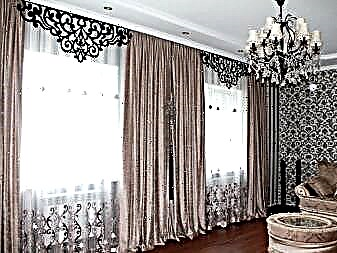
Openwork lambrequins are made using hard materials on which a pattern is applied and cut, further decorated with all kinds of elements. These lambrequins are called bando. The most popular model today is a custom-made bando with laser edge processing. However, they are quite expensive, and many people prefer to buy a decorative strip on the ledge. Such a bar is a tape with a repeating pattern, from which you can cut the required length, fix it on the ledge and the openwork lambrequin is ready. Figured pelmet can be done independently.
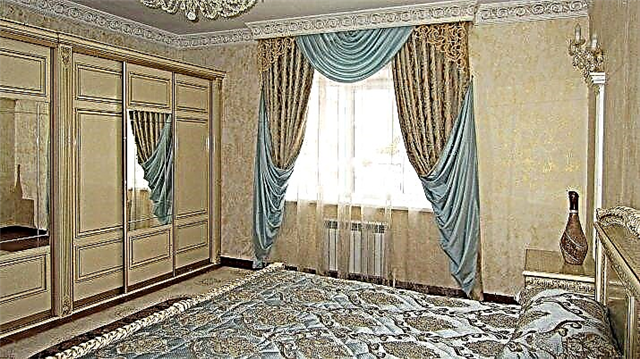
There are two types of bando. The first consists of several curly elements and is called combined. The second is a one-piece pattern, made individually for window measurements. The combined lambrequin consists of three types of elements: central, side strips and corner. With a small window width, you can stop using only the central and corner ornaments, refusing to buy side slats. At the same time, when designing a long cornice, you can use several side strips.
Figured elements are performed manually by the cavity, with the exception of edge processing. Such a custom-made bando will turn out to be quite expensive due to the huge amount of monotonous and scrupulous work of the master.
At the same time, it’s rather difficult to make a figured pelmet. To achieve a perfectly smooth contour, you need to make a lot of effort and time.
Openwork lambrequins are not suitable for installation in every room. The climatic features of the room, its functional purpose are very important. So, curly bando can not be used for window decoration in the kitchen, except when the latest hoods, ventilation and air conditioning systems are installed in it. Greasy sediment will be clearly visible on shiny fabric, and the material itself may swell, deform. The general appearance of the interior will be completely ruined.

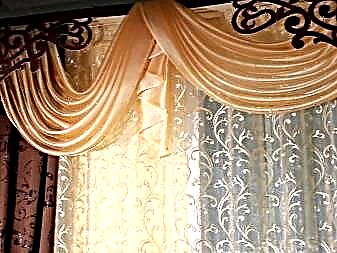
Also, you can not install openwork lambrequins in the bathroom for the same reasons: the constant exposure to hot steam will damage the lambrequin. In addition to the lambrequins themselves, you can order or make decorative elements that resonate with them, for example, hooks for curtains.
Manufacturing technique
To make openwork lambrequins yourself, you need to thoroughly prepare:
- First you need stencils. Various patterns and sketches can be found on the Internet, then simply print and cut. If a full-sized suitable pattern was not found, you can enlarge it with graph paper, and then transfer it to a more durable material. Usually templates are made from whatman paper for drawing or dense wallpaper. Previously they need to be spread on the floor, pressed on the sides and left overnight. So you completely straighten the sheet, and the pattern will not roll into a roll.
This is what the stencils look like. They are presented in the public domain. Anyone can download them, increase to the required size and create their own unique author's lambrequin.


- After the workpiece is done, translate the pattern directly on a bandeau base. Bando can be either self-adhesive or hot-melt.
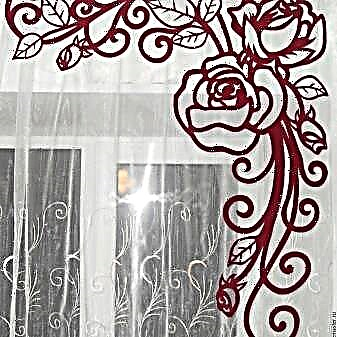

- Next, it's time to lay down the main decorative material. When choosing a fabric, pay attention to the fact that it must be synthetic. Natural materials for the manufacture of lambrequins are not suitable. Matter should not be loose, since there is a risk that the edges are fanned and will look messy. Also, the synthetics you have chosen should be of a dense texture and keep their shape well. Most often, an openwork lambrequin is made from a fabric such as satin.
Iron the fabric carefully before the bando sticker. Otherwise, wrinkles and bumps may form on the material. Glue the fabric to the base, depending on the type of bando you choose. Usually it is enough just to iron the fabric, first with steam, then without it.
- Decide how you will process the edges of your future lambrequin. If possible, you can use a laser. Laser cutting is good because the edges are perfectly smooth at the same time, and the material is “soldered” around the edges. The disadvantage of this method is that under certain angles of view light bando material will be visible. In general, this method is recognized as the best today.


- Burning patterns is another great way to get a neat and beautiful result. Guilloche or creating delicate patterns on fabric with the help of burning appeared not so long ago, however, it immediately won an army of fans. You will need only a special apparatus for burning, a little skill and patience. This method is much more practical than laser cutting, since many have a burning machine at home.
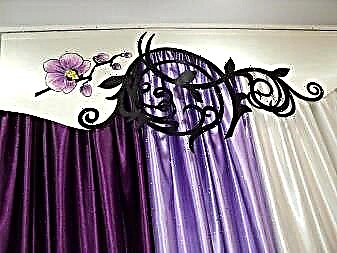

- The most affordable way to trim the edge is to use an overlock or sewing machine.. In this case, you need to lay a couple of centimeters of fabric on each side for seam allowances. When machining the edges with a slanting edge, allowances are not added. To achieve perfect smoothness of the edge is almost impossible when using this method. It is also very painstaking, since all lining is done manually, with the exception of places where it is possible to use an overlock. Small twisted patterns to make using this technique also will not work.

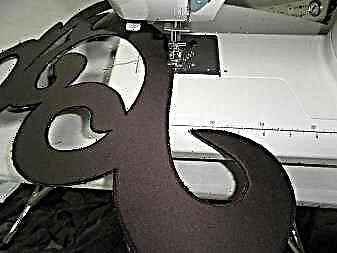
- Further, at your discretion, you can glue the lining on the wrong side of the pelmethowever, usually the bando from the inside looks pretty good. Next, you need to work on a method of attachment. Usually Velcro tape is used for these purposes. The soft fleecy side is attached to the lambrequin, and the sticky layer of tape is glued using double-sided tape to the ledge.
Note that using the fleecy side if there is no lining is optional. The base of the bando is perfectly attached to the sticky part of the tape.

You can watch a detailed master class on making openwork lambrequin in the next video.
How to choose?
Reading the reviews of people who made their own or bought patterned bando for curtains, you can come to the following conclusions:
- Many do not recommend making a felt base, as this material is not rigid enough. However, doublerin is an excellent replacement that allows you to create any lace shapes. Openwork in this case will turn out light, neat, thin.
- You can trim the edge not only with an oblique trim. Kant around the edge looks very stylish and modern, focusing on the pattern. At the same time, it will help to “hide” bumps along the edges.
- Various decoration items are often used to decorate a lambrequin. Decal perfectly helps to dilute the color and pattern. For example, flowers glued over a lace lambrequin look very nice. Patterned ornaments also look relevant. You can choose an interesting embroidery on the curtains that echoes the bando.
- In order for the lambrequin to look more harmonious in the room, you can add various decoration elements that resonate with it. For example, cord hooks will be a great addition to lace fringe bando. It is also important that the color of the pelmet is combined with the surroundings. Ideally, choose a shade that is repeated in the rest of the interior. For example, openwork golden lambrequin, gilded door handles, gilded headboard - a very harmonious “trio”.
- When choosing a ready-made lambrequin represented by a solid strip, pay attention to the pattern. You can choose an ornament, the repetition step of which is from 1 m to 4.5 m. It is important to buy such a strip with a small margin, since it is necessary to hide the corners of the cornice.

- Often there are cornices with rounded sidewalls. The owners of such cornices are very lucky, they can afford to buy a pelmet exactly the same length as the length of the cornice. For owners of simple direct cornices, it is better to slightly bend the edges of the tape, hiding inaccurate sections.
- Another factor that is of great importance when choosing a suitable openwork lambrequin is the shape of the window and the shape of the room as a whole. So, a narrow window can be visually enlarged if you make the pelmet wide, and hang the curtains so that they cover a little space around the window, at the same time without covering the frame itself.
- In a narrow room, it is advised to install a wall-wide lambrequin. By choosing light colors, you can visually expand the space of the room.
- If the ceilings in the room are low, it is better to refuse to install a carved bando. He "steals" a few more centimeters of height, making the room cramped. However, this does not apply to very delicate models; on the contrary, they look very good.
- The style decision of the room also plays an important role. So, for modern styles, it is advised to choose not very openwork models, advising to leave the baroque openwork and classics.
- The minimalistic design looks good lace lambrequin made of large parts. For the Scandinavian style, an eco-theme made in graphic abstract design is well suited.
- For classic, baroque, rococo, art deco, as well as ethnic Indian interiors - the more details, the better. Ornate exquisite designs are welcome here.

How to care and clean?
Caring for lace lambrequins is not difficult. Carved bando cannot be washed in a washing machine and generally try to avoid wet cleaning whenever possible, but they lend themselves perfectly to dry care.Using a regular clothes brush you can get rid of dust and dirt. Due to the fact that synthetic fabrics are used for the manufacture of lambrequins, you can not worry about their structure and color saturation.
If the pollution is strong, you can use very little water and washing powder or washing gel:
- Dilute the powder with water until a mushy state. It is not necessary to breed gel.
- Remove the lambrequin and lay it on the floor.
- Apply the product on a stain, distribute and leave for about 10 minutes. Using a brush, try to wipe away the dirt as much as possible. Do not overdo it, as you can deform the lambrequin.
- Use a soft sponge and water to remove traces of the product from the cloth. Try not to wet the bandeau too much, use a slightly damp sponge.
- Iron the pelmet several times with an iron.

As you can see, cleaning the lambrequin does not take much time. The basic rule is to be careful. Then a pure bando will please you for a long time.
Options in the interior
A great option for decorating a wide window in the living room. The color of the openwork bando is selected for the general color scheme of the room. Sumptuous floor-length pleated curtains help balance the overall window area, making it more proportionate.

Here is another living room, the panoramic window of which is beautifully decorated. As in the previous example, the color of the pelmet is matched to the overall color background of the interior.
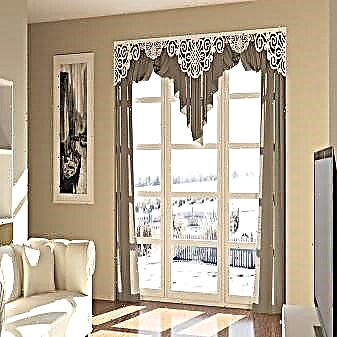

This living room is traditional in style. Classical lambrequin patterns complement the overall composition of the room, emphasizing its rigor and elegance.
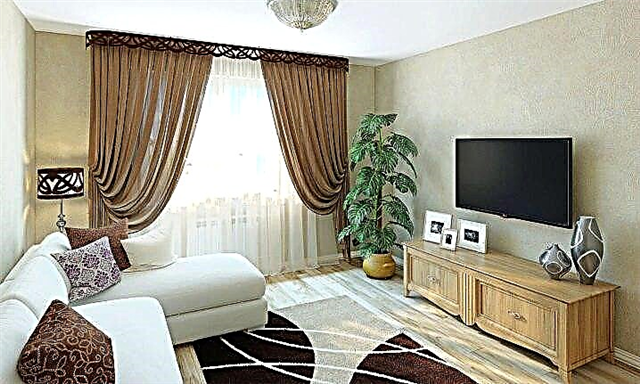
And again the classic style. Please note that the cornice is not decorated with a combined lambrequin, but made of a continuous ribbon. The repeating pattern looks amazing and does not look boring. A contrasting color scheme helps visually add a few centimeters in height to the room.
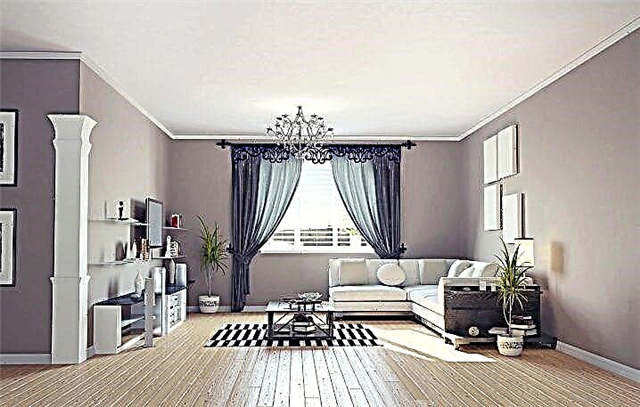
Another window design using a continuous tape bando. The selection of various patterns is huge. You can find not only classical ornaments, but also floral or romantic, for example, lambrequins with hearts.

In this interior, a pelmet with an abstract floral pattern was used.

New items appear on the carved bando market. So, this sample fits perfectly into the loft style bedroom. He looks very fashionable and modern. Black color looks harmonious, complementing the overall compositional idea.

Roses are a common theme for lace bando. This model is suitable for almost any interior and looks very impressive. The photo shows the angular and central structural elements. Due to the large size of the pelmet, it was not required to supplement it with side slats.

Often people prefer more traditional models. For example, this photo shows a modest pelmet with a curly hem and contrasting trim. It looks interesting and at the same time simple, without burdening the space. However, the choice of such a model makes the ceiling lower, while a very openwork model could add a few centimeters to the height of the ceiling.

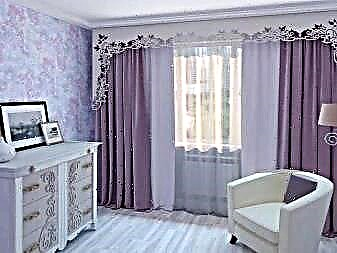
Here is an example of how a figured bando can be combined with the general style of a room not only in color but also in ornament. Floral themes are repeated in the lambrequin pattern, which duplicates wall decorations in content. Bright raspberry color is correctly muted by dark gray, which makes it look elegant and sophisticated.
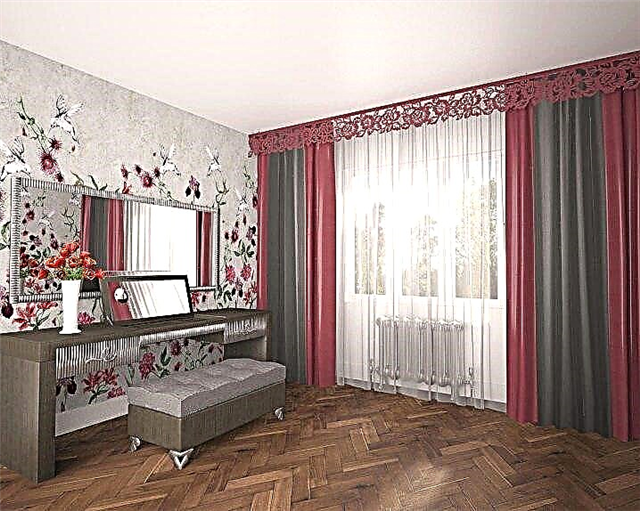
The figured lambrequin, complemented by decals in the form of flowers, looks lively and cute. Complemented by curtain captures made in the same stylistic range, it fits perfectly into the interior of the room, masking the window too narrow and visually making it wider.
Modular
They consist of several patterned compositions of various heights. With the help of a modular structure, you can create and assemble the most unusual fantasy patterns and drawings that will blend perfectly with the curtains.
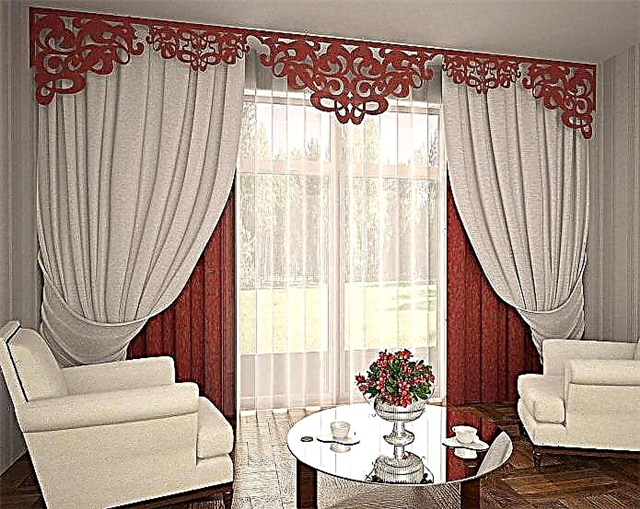
Planck
They are made in rolls with the same patterned pattern along the entire length. Tape lambrequins can be used both as a composite and a separate decorative element.

In the photo, a plank openwork lambrequin in the interior of the nursery.
Cords
Fascinate with its artistic beauty and original pattern. Several interwoven multi-colored cords form a complex weave and create a three-dimensional effect. Curtains decorated with such decor look really luxurious.

Dense, soft material with a fleecy and matte surface. Outwardly similar to velvet or velor.

Tree
Openwork lambrequins made of wood cause associations with wooden platbands, which are used to decorate the windows of houses. Products from such material are quite expensive and will not be appropriate for every interior.
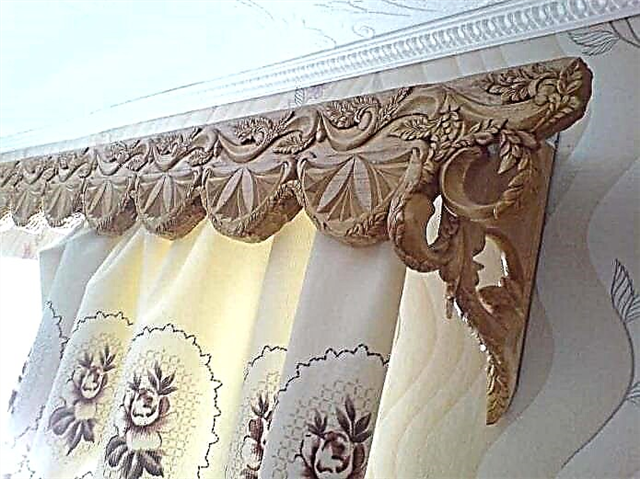
Kitchen
The choice of carved planks for the kitchen depends on its size. In a spacious room, more massive products in color combined perfectly, for example, with pickups for curtains, will look great. For small kitchens, ribbon lace lambrequins combined with light curtains are perfect.


In the photo there is a kitchen and a plank openwork lambrequin on the window.
Living room
In the living room, carved lace and bizarre compositions look very airy and exquisite and give the curtains and the whole room elegance.



Bedroom
The openwork decor of the bedroom window creates a certain atmosphere, enlivens the interior and smooths out contrasts. In addition, the lambrequin perfectly integrates curtains and curtains into a single whole.

The photo shows a window opening with an openwork lambrequin in the interior of the bedroom.


Classic
Openwork lambrequin with its elegant lines, will adequately adorn a window in a room in a classic style and will attract attention with its sophistication.



Modern
In a modern style, openwork lambrequins with elegant lace ornaments are perfect for decorating a window opening. They will bring air sophistication to the room and will not burden the interior.

In the photo, the openwork lambrequin in the living room in a modern style.

Modern
Carved planks will give completeness, expressiveness and luxury to the interior in this style, and will give it a certain level of respectability and showiness.
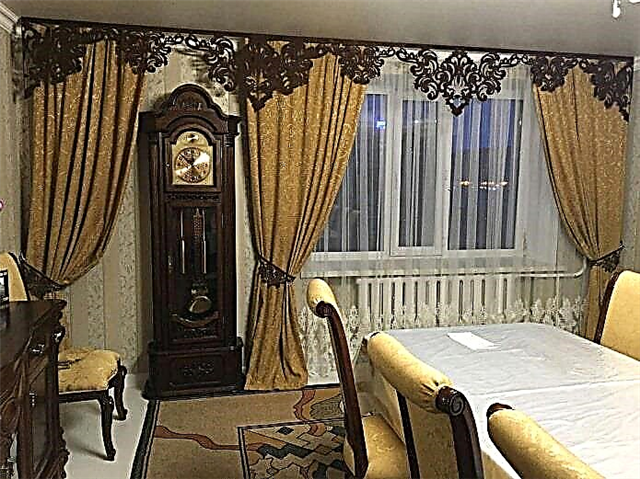

Red
Gives the room piquancy, attracts glances, raises the mood and makes the atmosphere more solemn.


Brown
Universal and quite relevant color, which is very common in interiors.

Pictured is a brown openwork lambrequin in the living room.

With flowers
With such decoration as flowers, the window turns into a real work of art and creates a semantic completeness of the design of the entire room.


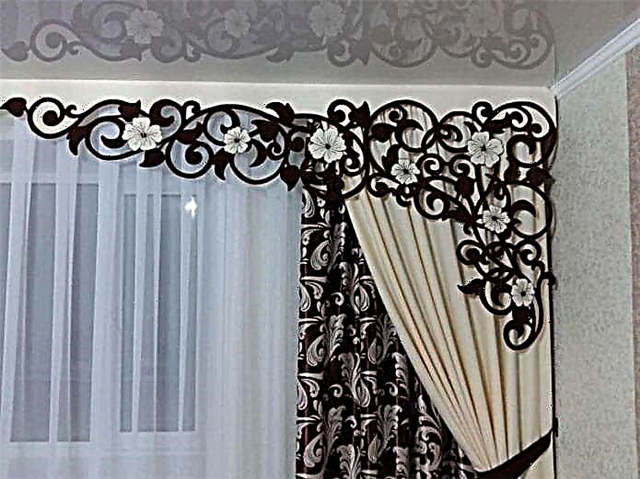
Bicolor
The textile combined decor of two colors expands the possibilities and makes the window opening truly unique.



Asymmetric
Lambrequin with asymmetry gives the window solidity, solemnity and charm. The main thing is that it conforms to the general interior concept and harmonizes with curtains.



Portiere
Combinations have an unlimited flight of fancy. Openwork strips on the cornice complement the curtains and give them a complete look.


Roman curtains
Practical Roman curtains in combination with figured decor create a convenient and compact design, which is a pretty stylish solution for window decoration.


Bay window
Lambrequin in a special way emphasizes the shape of the bay windows and creates a holistic composition.
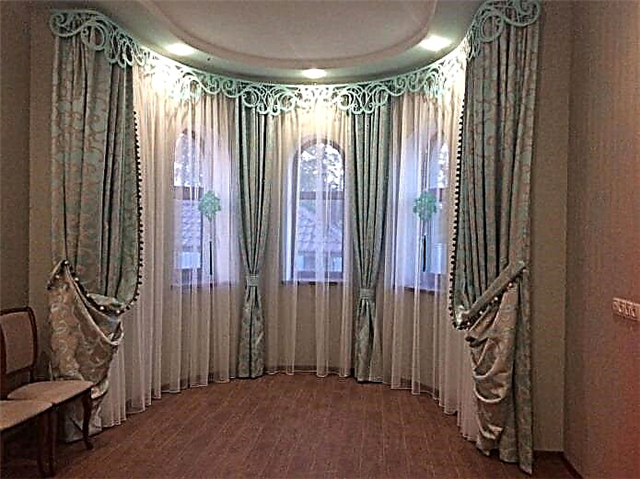
In the photo a bay window decorated with openwork lambrequin.

On the arched window, such structures look quite impressive and perfectly highlight the advantages of the window.
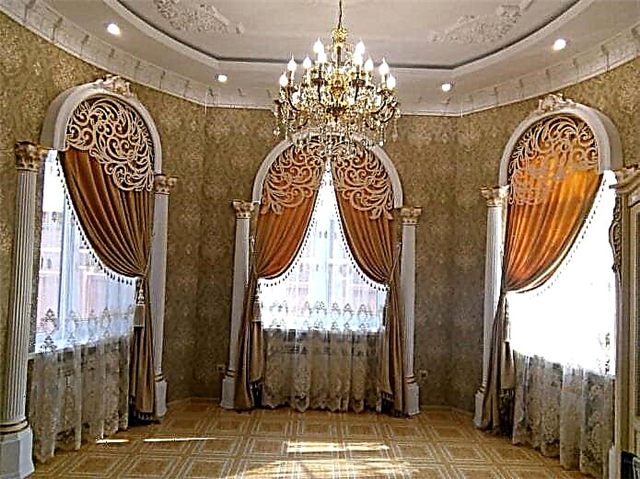
In the photo, openwork lambrequins on arched window openings.



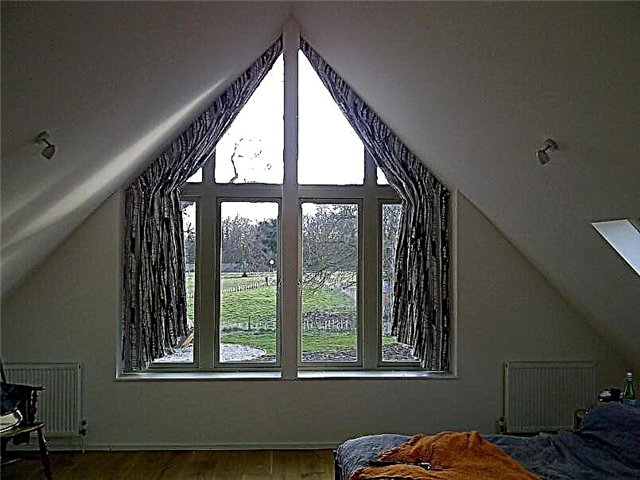
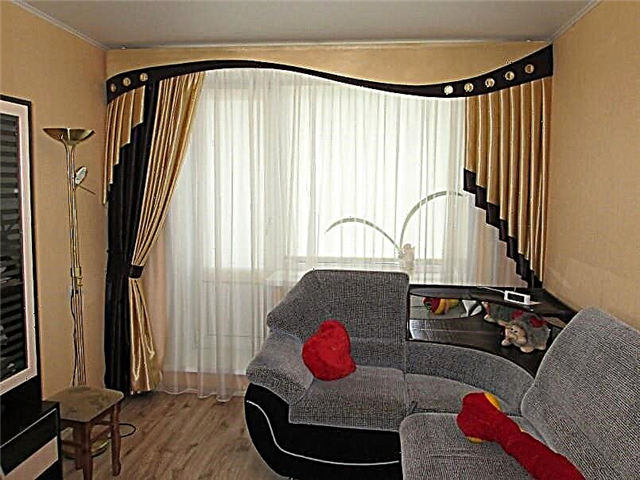
 its color should correspond to the main color scheme of the room - it may not be combined with the color of the lace on the curtain,
its color should correspond to the main color scheme of the room - it may not be combined with the color of the lace on the curtain,
